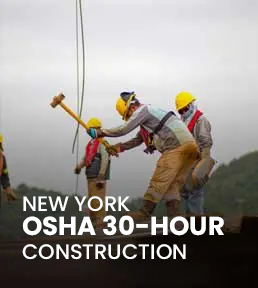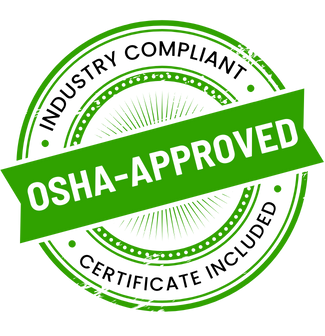HAZWOPER 8-Hr Refresher Training

74% workers report workplace conditions due to HAZWOPER training. The HAZWOPER 8-Hr Refresher Training 29 CFR 1910.120/29 CFR 1926.65 (IACET CEU=0.8) is an online course designed to meet the annual training requirements for employees involved in hazardous waste operations and emergency response. This OSHA-compliant training ensures that participants are updated with the latest safety protocols and regulatory standards. Topics covered include hazard recognition, confined space entry, air emissions, stormwater management, hazardous waste handling, and emergency response procedures. Professionals across industries can benefit from getting a HAZWOPER certification.
Why Workers Choose Us
| features |  |
other providers |
|---|---|---|
| One Free Course With Certificate | ||
| Free Second Attempt If Failed | ||
| Plastic DOL Card (Free Delivery) | ||
| Instant Downloadable Certificate | ||
Free Study Guide

|
||
| Discounts For Businesses
×

|
||
| Buy Now, Pay Later
×
You can avail this offer on checkout
 NEW
NEW
|
||
| No Hidden Cost | ||
| Mobile Compatibility
×
Learn on the go.

|
||
| Flexible Learning
×
Learn on your time.

|
HAZWOPER Training Video
Watch this video before enrolling in the HAZWOPER certification course.
Satisfied Customers
Learning Objectives
- Understand the key requirements of OSHA's HAZWOPER standards (29 CFR 1910.120/29 CFR 1926.65).
- Recognize and evaluate hazardous materials and the potential risks they pose.
- Learn the procedures for safe confined space entry and the importance of permits.
- Understand best practices for managing air emissions and stormwater.
- Gain knowledge about hazardous waste handling, storage, and disposal.
- Learn how to respond to spills, fires, and other emergencies in compliance with OSHA regulations.
- Understand the importance of personal protective equipment (PPE) and how to use it effectively.
Course Outline
HAZWOPER Refresher Training - Module 1 - Scope, Application and Training Requirements
-
1. Introduction
- Welcome
- HAZWOPER Refresher Training
- Course Overview
- Introduction
- Learning Objectives
-
2. Definitions
- Definitions
- Hazardous Substance
- Legal Definitions
- Hazardous Waste
- Knowledge Check: Definitions
-
3. Hazardous Materials Incidents
- Love Canal
- Hurricane Katrina
- Knowledge Check: Love Canal
- Knowledge Check: Hurricane Katrina
-
4. Laws and Agencies
- Laws and Agencies
- OSH Act
- RCRA
- CERCLA
- HSWA
- SARA
- EPA and OSHA
- Learning Activity – Which Regulation Is It ?
- Learning Activity – Which Regulation Is It ?
- Learning Activity – Which Regulation Is It ?
- Learning Activity – Which Regulation Is It ?
- Learning Activity – Which Regulation Is It ?
- Learning Activity – Which Regulation Is It ?
-
5. Standards
- OSHA HAZWOPER Standard
- What You Need to Know about HAZWOPER
- Additional OSHA Standards
- Knowledge Check: HAZWOPER Standard
- Knowledge Check: HAZWOPER Standard
-
6. Training Requirements
- HAZWOPER Training Requirements
- Initial Training Requirements
- Site Workers
- Refresher Training Requirements
- Learning Activity – Who Needs This Training ?
- Safety and Health Training Programs
- Site-Specific Safety and Health Plan
-
7. Conclusion
- End of Module
HAZWOPER Refresher Training - Module 2 - Environmental Issues for HAZWOPER (US)
-
1. Introduction
- Welcome
- Course Overview
- Introduction
- Learning Objectives
- EPA Regulated Areas
-
2. Hazardous Waste
- Hazardous Waste Generation
- Hazardous Waste Categories
- Hazardous Waste Evaluation
- Hazardous Waste Generator Classifications
- Learning Activity – Hazardous Waste Generator Classification
- Hazardous Waste Generator Classifications (continued)
- Hazardous Waste Accumulation
- Knowledge Check: Hazardous Waste Generator
- Knowledge Check: Hazardous Waste Evaluation
-
3. Non-hazardous Waste
- Non-hazardous Waste
- Special Management
-
4. Industrial Wastewater
- Industrial Wastewater Discharges
- Industrial Wastewater Discharges to Surface Waters
- Industrial Wastewater Discharges to a Municipal Treatment Plant
- Knowledge Check: Industrial Wastewater
-
5. Stormwater
- Stormwater Discharges
- EPA Exemptions
- SWPPP
- Knowledge Check: Stormwater
-
6. Permits and BMPs
- Permits
- Operating Practices
- Industrial Waste BMPs
- Industrial Waste Storage
- Industrial Waste Spills and Containment
- More Industrial Waste BMPs
- Learning Activity – Industrial Waste BMPs
-
7. Conclusion
- End of Module
HAZWOPER Refresher Training - Module 3 - Hazard Communication: Your Right to Know
-
1. Introduction
- Welcome
- Course Overview
- Introduction
- Learning Objectives
-
2. HazCom Standard Purpose
- Purpose of the Hazard Communication Standard
- Knowledge Check: HazCom Standard Purpose
-
3. HazCom Standard Areas
- Who Is Covered by the Standard?
- Parts of the Standard
- Learning Activity: Four Major HazCom Standard Areas
-
4. GHS
- Globally Harmonized System of Classification and Labelling of Chemicals (GHS)
-
5. Types of Hazards
- Chemical Hazards
- Physical Hazards
- Health Hazards
- Knowledge Check: Types of Hazards
- Knowledge Check: Types of Hazards (continued)
-
6. Responsibilities
- Employer Hazard Communication Responsibilities
- Manufacturer and Importer Hazard Communication Responsibilities
- Learning Activity: Hazard Communication Responsibilities
-
7. Inventory and Written Program
- Hazardous Chemicals Inventory
- The Written Program
-
8. Label Requirements
- Labels
- Additional Label Requirements
- Common Rating Systems Used in Labeling
- Learning Activity: Pictograms
-
9. Safety Data Sheets
- SDS Requirements
- Safety Data Sheets (SDSs)
- SDS Format
- Knowledge Check: Reading an SDS
- Knowledge Check: Reading an SDS (continued)
- Knowledge Check: Reading an SDS (continued)
- Knowledge Check: Reading an SDS (continued)
- Knowledge Check: Reading an SDS (continued)
- Knowledge Check: Reading an SDS (continued)
-
10. Information and Training
- Information and Training
- Employer Training Responsibilities
- Training Requirements
-
11. Summary
- Summary
HAZWOPER Refresher Training - Module 4 - Hazard and Risk Assessment Techniques*
-
1. Introduction
- Welcome
- Course Overview
- Introduction
- Learning Objectives
-
2. Definitions and Classifications
- Definitions
- Methods of Hazard Classification
- Knowledge Check: Risk
-
3. Chemical and Physical Properties of Hazards
- Toxicity
- Corrosivity
- Flammability and Explosibility
- Instability and Reactivity
- Pyrophoric Material
- Knowledge Check: Corrosives
- Knowledge Check: Ignitability
- Oxidizers
- Asphyxiants
- Cryogenic Materials
- Ionizing Radiation, Radioactive Materials and Radioactive Wastes
- Learning Activity
- Learning Activity
- Learning Activity
- Learning Activity
- Learning Activity
- Learning Activity
-
4. Hazard Identification I
- Hazard Identification
- OSHA Standard
- EPA Definition
- Senses and Location
- DOT Requirements
- Color-Coding Placards
- Word- and Symbol-Coding
- Number-Coding
- DOT Hazard Classes
- DOT Requirements for Transport
- Knowledge Check: Placards 1
- Knowledge Check: Placards 2
- Knowledge Check: Placards 3
- Knowledge Check: Placards 4
-
5. Hazard Identification II
- Highway Transport Container Shapes
- Railway Container Shapes
- Stationary Container Shapes
- Drums
- Other Containers
- Knowledge Check Introduction
- Knowledge Check: Container Shapes 1
- Knowledge Check: Container Shapes 2
- Knowledge Check: Container Shapes 3
- Knowledge Check: Container Shapes 4
- Process Hazards
-
6. Risk Assessment
- Recognizing an Emergency
- Size up the Scene
- Source and Size
- Effects, Characteristics and Preliminary Identification
- Knowledge Check: Release
- Knowledge Check: Presence of Hazards
- Knowledge Check: Risk Assessment
-
7. Conclusion
- End of Module
Flammable and Combustible Liquids
-
1. Introduction
- Welcome
- Introduction
- Learning Objectives
-
2. Definitions and Classes
- Flammable and Combustible Liquids
- Hazardous Vapors
- Flammable Versus Combustible
- Knowledge Check: Flash Point
- Knowledge Check: Flammable Versus Combustible
-
3. Risks and Safety Procedures
- Your Workplace’s Procedures
- Activity: Controlling the Components of Fire
- Potential Ignition Sources
- Static Electricity
- Bonding and Grounding
- Special Equipment
-
4. Storage Methods
- Storage Rooms
- Using Storage Rooms
- Storage Cabinets
- Outside of Storage Rooms and Cabinets
- Containers
- Safety Cans
- Transferring Liquids
- Knowledge Check: Amount
- Knowledge Check: Transfer
-
5. Housekeeping and Fire Control
- Housekeeping
- Fire Control
- Industry-Specific Requirements
-
6. Conclusion
- Conclusion
Fire Extinguisher Safety: Part 1 - Fight or (US)
-
1. Introduction
- Welcome
- Before You Fight a Fire
- Your Goals
-
2. Know the Risks
- Risky Business
- Activity: Intensity
- Activity: Extinguishing Agent
-
3. Fight or Flee?
- How to Decide
- Fight
- Flee
-
4. Practice Deciding
- Decisions
- Activity: Boiler Room
- Activity: Trash Can
- Activity: Smoke
-
5. Fire-Fighting Overview
- Important
- Fighting Fires
- Evacuation
-
6. Conclusion
- Summary
Fire Extinguisher Safety: Part 2 - Using Extinguishers (US)
-
1. Introduction
- Welcome
- Effectively Putting Out Fires
- Your Goals
-
2. How Extinguishers Work
- Elements of Fire
- Pressurized Canister
- Extinguishing Agents
- Knowledge Check: Elements of Fire
-
3. Fire and Extinguisher Types
- Why Fire Type Matters
- Learning Activity: Extinguisher Labels
- More about Fire Types
- Learning Activity: Choose Appropriate Extinguishers
-
4. Fire-Fighting Overview
- Important
- Clear the Area
- While You Evacuate the Area
- Prepare to Extinguish the Fire
- Fight the Fire
- Reminder
- Knowledge Check: Steps
-
5. PASS Method
- Pull
- Aim and Squeeze
- Sweep
- Learning Activity: Operating an Extinguisher
-
6. Best Practices
- Hands-on Training
- Placement
- Maintenance
- Knowledge Check: What Would You Do?
-
7. Conclusion
- Summary
HAZWOPER Refresher Training - Module 5 - Toxicology
-
1. Introduction
- Welcome
- Course Overview
- Introduction
- Learning Objectives
-
2. Key Terms
- Key Terms
- Threshold Limit Value (TLV)
- LD50, LC50 and PEL
- IDLH
- Route of Entry
- Learning Activity: Key Terms
-
3. Routes of Entry
- Skin Absorption
- Inhalation
- Ingestion and Injection
- Knowledge Check: Routes of Entry
- Knowledge Check: Routes of Entry (continued)
-
4. Responses to Toxic Exposure I
- Acute Exposure
- Chronic Exposure
- Types of Responses
- Local Effects
- Systemic Effects
- Knowledge Check: Toxic Exposure
- Knowledge Check: Toxic Exposure (continued)
-
5. Responses to Toxic Exposure II
- Target Organs
- Body Reactions
- Learning Activity: Target Organs - Eye Hazards
- Learning Activity: Target Organs - Pulmonary Hazards
- Learning Activity: Target Organs - Hepatotoxins
- Learning Activity: Target Organs - Neurotoxins
- Learning Activity: Target Organs - Nephrotoxins
- Learning Activity: Target Organs - Reproductive Toxins
- Reaction-Influencing Factors
- Dose-Response Relationship
- Toxic Exposure Guidelines
- Knowledge Check: Reactions to Toxic Exposure
- Knowledge Check: Reactions to Toxic Exposure (continued)
-
6. Conclusion
- End of Module
Ionizing Radiation
-
1. Introduction
- Welcome
- Introduction
- Learning Objectives
-
2. Definition
- What Is Ionizing Radiation?
- Radiation Concepts
-
3. Types of Radiation
- Learning Activity – Types of Radiation
- Types of Radiation
- Learning Activity – Radiation Penetration
-
4. Sources of Radiation
- Sources of Radiation
- Sources of Radiation (continued)
- Occupational Exposure
- Knowledge Check: Sources
-
5. Exposure Limits and Health Effects
- Occupational Exposure Limits
- Potential Health Effects
- Potential Health Effects: Exposed Individual
- Potential Health Effects: Future Children
- Potential Health Effects: Prenatal Effects
- Knowledge Check: Health Effects
- Risks of Working Around Radiation
-
6. ALARA Program
- ALARA Program
- Minimizing Time
- Increasing Distance
- Shielding
- Learning Activity – As Low As Reasonably Achievable
-
7. Controlling Exposure Levels
- Radiological Controls
- Radiological Controls (continued)
- Monitoring Exposure
- Knowledge Check: Controls
-
8. Emergencies
- Emergencies
- Emergency Evacuation
- Knowledge Check: Emergencies
-
9. Conclusion
- Summary
- Conclusion
Hydrogen Sulfide (H2S) Awareness
-
1. Introduction
- Welcome
- Would You Know What to Do?
- You CAN Work Safely
- Your Goals
-
2. What Is Hydrogen Sulfide?
- Where Is Hydrogen Sulfide?
- Characteristics
- Knowledge Check: Sight
- Knowledge Check: Smell
- Knowledge Check: Warning
- Health Effects
- Knowledge Check: First Signs
-
3. What Protection Should I Use?
- Detection
- Knowledge Check: Respirators
- Respirators
-
4. What Should I Do?
- Knowledge Check: What Would You Do?
- Emergency Response Plans
- Rescue Safety – Before You Begin
- Rescue Safety – Help the Victim
-
5. Conclusion
- Knowledge Check: Training
- Key Takeaways
Using Eyewashes and Emergency Showers
-
1. Introduction
- Welcome
- Introduction
- Learning Objectives
- Important Information Before We Continue
-
2. Importance of Eyewashes and Emergency Showers
- Why Use Eyewashes and Emergency Showers?
- Knowledge Check: Why Use Eyewashes and Emergency Showers?
-
3. Recognizing Neglect
- When Will You Use Eyewashes or Emergency Showers?
- Learning Activity: Recognizing Neglect
-
4. Correcting Problems
- Improve Visibility and Remove Obstructions
- Keep Nozzles Clean
- Keep Water Clean
- Check Water Flow Rate
- Water Temperature and Flushing Time
- Learning Activity: Problems and Solutions
- Learning Activity: Problems and Solutions (continued)
- Learning Activity: Problems and Solutions (continued)
-
5. Best Practices
- Using Eyewashes and Emergency Showers
- Seek Medical Attention
- Additional Information
- Knowledge Check: Best Practices
-
6. Summary
- Summary
Personal Factors in Safety
-
1. Introduction
- Welcome
- Introduction
- Learning Objectives
-
2. Experience
- Experience
- Knowledge Check: What Will You Do?
- Experience Counts
- Experience Can Mislead
-
3. Judgment
- Activity: Limitations
-
4. Stress
- Stress
- Behavioral Effects of Stress
- Physical Effects of Stress
- Dealing with Stress
- Knowledge Check: Stress
-
5. Fatigue
- Fatigue
- Mental Fatigue: Causes
- Mental Fatigue: Effects
- Physical Fatigue
- Dealing with Fatigue
- Knowledge Check: Fatigue
-
6. Communication
- Knowledge Check: What Do You Think?
- Team Support
- Interacting
- Receiving Feedback
- Knowledge Check: Receiving Feedback
- Knowledge Check: Giving Feedback
-
7. Conclusion
- Summary
Preventing Slips, Trips and Falls
-
1. Introduction
- Welcome
- Introduction
- Learning Objectives
-
2. Definitions and Causes
- Slips, Trips and Falls Defined
- The Causes
- Knowledge Check: Definitions
- Knowledge Check: Definitions (continued)
-
3. Solutions
- The Solution
- Keep Work Areas Neat
- Keep Work Areas Well-lit
- Use Equipment Correctly
- Ladders
- Stairs
- Loading Docks
- Shoes
-
4. When a Fall Happens
- In the Event of a Fall
-
5. Conclusion
- Conclusion – Develop Good Habits
HAZWOPER Refresher Training - Module 6 - Monitoring and Medical Surveillance
-
1. Introduction
- Welcome
- Course Overview
- Introduction
- Learning Objectives
-
2. Monitoring
- Monitoring
- Monitoring Systems
- Air Monitoring
- Use of Monitoring Data
- What Can Be Monitored?
- What Can Be Monitored? (continued)
- Knowledge Check: Monitoring Systems
- Knowledge Check: Monitoring Data
- Knowledge Check: Oxygen-Deficient Atmospheres
-
3. Concentration and Limits
- Measures of Concentration
- Exposure Limits
- Knowledge Check: Short-Term Exposure Limit
- TWAs
- Explosive Limits
- Learning Activity: Concentration and Limits
-
4. Types of Monitoring and Equipment
- Types of Air Monitoring
- Monitoring Instruments
- Monitoring Instruments (continued)
- Learning Activity: Monitoring Devices
- Monitoring at an Emergency
- Limitations of Monitoring Equipment
-
5. Medical Surveillance
- Medical Surveillance Program
- Employees Covered
- Frequency of Medical Examinations
- Medical Evaluations
- Content of Medical Examinations
- Examinations
- Recordkeeping
- Knowledge Check: Medical Surveillance Program
- Knowledge Check: Medical Surveillance
-
6. Knowledge Check: Medical Exams
-
7. Conclusion
- End of Module
HAZWOPER Refresher Training - Module 7 - Respiratory Protection
-
1. Introduction
- Welcome
- Course Overview
- Introduction
- Learning Objectives
-
2. OSHA Standard
- The Respiratory Protection Standard
- Written Respiratory Protection Program
- Knowledge Check: Engineering Controls
- Knowledge Check: Written Program
-
3. Respirator Types
- Respirator Types
- Atmosphere-Supplying Respirators
- Supplied-Air Respirators (SARs)
- Self-Contained Breathing Apparatuses (SCBAs)
- Air-Purifying Respirators
- Powered Air-Purifying Respirators (PAPR)
-
4. Respirator Selection
- General Requirements for Respirator Use
- What Is the Nature of the Hazard?
- Other Factors
- Characteristics, Capabilities and Limitations
- APFs
- Emergency Response
- Learning Activity: Respirator Selection
- Learning Activity: Respirator Selection (continued)
-
5. Using a Respirator
- Medical Evaluations
- Seal Checks
- Learning Activity: Seal Checks
-
6. Maintenance and Care
- Maintenance and Care of Respirators
- Storage
- Knowledge Check: Maintenance and Care
-
7. Conclusion
- End of Module
HAZWOPER Refresher Training - Module 8 - Personal Protective Equipment (PPE)
-
1. Welcome
- Course Overview
- Introduction
- Learning Objectives
-
2. Selection Factors
- PPE Selection Factors
- PPE Selection Factors (continued)
- PPE Selection Factors (continued)
- Knowledge Check: PPE Selection Factors
- Knowledge Check: PPE Materials
-
3. Levels of Protection
- PPE Levels of Protection
- Level A Protection
- Level A Protection (continued)
- Level B Protection
- Level B Protection (continued)
- Level C Protection
- Level C Protection (continued)
- Level D Protection
- Level D Protection (continued)
- Learning Activity: Levels of PPE
- Knowledge Check: Hazardous Atmosphere 1
- Knowledge Check: Hazardous Atmosphere 2
- Knowledge Check: Hazardous Atmosphere 3
- Knowledge Check: Hazardous Atmosphere 4
-
4. Conclusion
- End of Module
Heat Stress
-
1. Introduction
- Welcome
- Introduction
- Learning Objectives
-
2. How the Body Handles Heat
- Internal Temperature
- Blood Circulation
- Concerns Related to Blood Circulation
- Sweat
- Knowledge Check: Humidity
-
3. Health and Safety Concerns
- Hot Locations
- Safety Concerns
- Health Concerns
- Learning Activity: Sunburn
- Learning Activity: Sunburn (continued)
- Heat Rash
- Heat Cramps
- Heat Exhaustion
- Knowledge Check: Health Concerns
- Heat Stroke
- While You Wait for Help
- Knowledge Check: What Should You Do?
- Knowledge Check: What's Next?
- Knowledge Check: While You Wait for Help
-
4. Reducing the Likelihood of Heat Stress
- Reduce Heat Stress
- Learning Activity: Preparing for Work
- Acclimate to the Heat
- Knowledge Check: Acclimatization
- Adjust the Way You Work
- Teamwork
- Rest Areas
- Reducing Heat in Work Areas
- Activity: Cooling Down
- Better Together
-
5. Conclusion
- Summary
Cold Stress
-
1. Introduction
- Welcome
- Introduction
- Objectives
-
2. Definition
- Definition
- Knowledge Check: Extreme Cold
-
3. Sources of Heat Loss
- Learning Activity: Sources of Heat Loss
- Knowledge Check: Sources of Heat Loss
-
4. Consequences of Exposure
- Consequences of Exposure to Cold
- More Consequences of Exposure to Cold
- Knowledge Check: Consequences of Exposure to Cold
-
5. Severe Effects of Cold Exposure
- Hypothermia
- Prevention
- Treatment
- Treatment for Severe Hypothermia
- Frostbite
- Frostbite Treatment
- Trench Foot
- Knowledge Check: Severe Effects of Cold Exposure
- Learning Activity: Severe Effects of Cold Exposure
-
6. Contributing Factors
- Contributing Factors to Cold Stress
- Other Contributing Factors to Cold Stress
- Safety Tips
- Knowledge Check: Contributing Factors to Cold Stress
-
7. Precautions
- Precautions
- Work Practice Controls
- Other Work Practice Controls
- Clothing
- Clothing Layers
- General Tips
- Learning Activity: Precautions
-
8. Conclusion
- Conclusion
HAZWOPER Refresher Training - Module 9 - Confined Spaces
-
1. Introduction
- Welcome
- Course Overview
- Introduction
- Learning Objectives
-
2. Definitions
- Confined Space Criteria
- Permit-Required Confined Space
- Hazardous Atmosphere
- Learning Activity: Sewer Entry
- Learning Activity: Bulk Storage Tank
- Learning Activity: Pipe Chase
- Learning Activity: Large-Diameter Tank
- Learning Activity: HVAC Ventilation Duct
-
3. Responsibilities & Training
- Your Employer’s Responsibilities
- Training
-
4. Permits and Hazards
- Confined Space Permit
- Confined Space Hazards
- Confined Space Hazard Controls
-
5. Roles and Responsibilities
- Who Is Affected by the Standard?
- Authorized Entrant
- Authorized Entrant (continued)
- Attendant
- Attendant (continued)
- Entry Supervisor
- Learning Activity: Roles and Responsibilities
-
6. Procedures
- Plan the Entry
- Guard the Space
- Isolate the Space
- Learning Activity: Guarding and Isolating Confined Spaces
-
7. Atmospheric Hazard Controls
- Eliminate or Control Atmospheric Hazards
- Atmospheric Controls
- Test the Space for Atmospheric Hazards
- Knowledge Check: Atmospheric Hazards
- Knowledge Check: Atmospheric Testing
-
8. Necessary Equipment
- Identify Necessary Equipment (continued)
- Identify Necessary Equipment
- Knowledge Check: Confined Space Entry Equipment
-
9. Emergency Responders
- Emergency Responders
- Knowledge Check: Emergency Response
-
10. Emergency Procedures
- Plan for Emergencies
- Evacuation Procedures
- More Evacuation Procedures
- Knowledge Check: Confined Space Rescue
- Knowledge Check: Confined Space Rescue (continued)
-
11. Summary
- Summary
HAZWOPER Refresher Training - Module 10 - Spill Prevention
-
1. Introduction
- Welcome
- Course Overview
- Introduction
- Learning Objectives
- Spill Prevention
- Knowledge Check: Spill Prevention
-
2. Drums and Containers
- Basic Precautions
- Opening Drums and Containers
- Safe Handling
- Shipping or Transporting
- Knowledge Check: Unlabeled Drums
-
3. Incident Response
- Extinguishing Fires
- Spill Control Agents
- Spill Response Tools
- Learning Activity: Incident Response
-
4. Physical Methods of Leak Control
- Physical Methods of Leak Control
- Absorption
- Covering and Dilution
- Dikes, Dams, Diversion and Retention
- Vapor Dispersion and Overpacking
- Plugging and Patching
- Transfer
- Blanketing and Venting
- Knowledge Check 1: Leak Control
- Knowledge Check 2: Leak Control
- Knowledge Check 3: Leak Control
-
5. Chemical Methods
- Adsorption
- Burning, Flaring, Gelation and Neutralization
- Polymerization, Solidification, Suppression, and Vent and Burn
- Learning Activity 1: Methods of Leak and Spill Control
- Learning Activity 2: Methods of Leak and Spill Control
- Learning Activity 3: Methods of Leak and Spill Control
- Learning Activity 4: Methods of Leak and Spill Control
- Learning Activity 5: Methods of Leak and Spill Control
-
6. Conclusion
- End of Module
HAZWOPER Refresher Training - Module 11 - Site Control
-
1. Introduction
- Welcome
- Course Overview
- Introduction
- Learning Objectives
-
2. OSHA Standard and Engineering Controls
- Site Control Requirements
- Engineering Controls
- Knowledge Check: Controls
- Knowledge Check: Engineering Controls
-
3. Site Map and Work Zones
- Site Control Plan
- Site Map
- Knowledge Check: Site Map
- Work Zones
- Learning Activity – In The Zone! 1
- Learning Activity – In The Zone! 2
- Learning Activity – In The Zone! 3
- Learning Activity – In The Zone! 4
- Learning Activity – In The Zone! 5
-
4. Other Elements of a Site Control Plan
- The Buddy System
- Communications
- Security Controls
- Standard Operating Procedures
- Medical Assistance and Training
- Decontamination
- Knowledge Check: Buddy System
- Knowledge Check: Communication
- Knowledge Check: Stands Operating Procedures
-
5. Conclusion
- End of Module
HAZWOPER Refresher Training - Module 12 - Decontamination
-
1. Introduction
- Welcome
- Course Overview
- Introduction
- Learning Objectives
-
2. Definitions and Standards
- Decontamination
- The OSHA Standard
-
3. Contamination and Prevention
- Personnel Contamination
- PPE
- Prevention of Contamination of Personnel and Equipment
- Knowledge Check: Contamination
- Knowledge Check: Standard Operating Procedures
-
4. Decontamination Plan
- Planning for Decontamination
- Knowledge Check: Planning for Decontamination
-
5. Decontamination Methods
- Physical Removal
- Inactivation
- Chemical Removal
-
6. Decontamination Procedures & Equipment
- Decontamination Procedures and Facility Design
- Decontamination Line Arrangement
- Learning Activity: Decontamination Line
- Decontamination Equipment
-
7. Disposal and Precautions
- Disposal of Contaminated Materials
- Decontamination Precautions
- Knowledge Check: Disposal
-
8. Conclusion
- End of Module
HAZWOPER Refresher Training - Module 13 - Emergency Response
-
1. Introduction
- Welcome
- Course Overview
- Introduction
- Learning Objectives
-
2. On-Site and Off-Site Emergencies
- Emergencies
- On-Site and Off-Site Emergencies
- Knowledge Check: On-Site and Off-Site Emergencies
-
3. Preplanning Emergencies
- Preplanning Emergencies
- Additional ERP Elements
- Off-Site ERP
- Knowledge Check: ERP
- Knowledge Check: Off-Site ERP
-
4. Personnel & Training
- Personnel
- Training
- Learning Activity – On the Level
-
5. ERP Elements
- Emergency Recognition and Prevention
- Safe Distances and Refuges
- Site Safety and Security Plan
- Site Mapping
- Evacuation Routes and Procedures
- Knowledge Check: Safe Distances
- Knowledge Check: Safety and Security Plan
-
6. Decontamination & Medical Treatment
- Decontamination
- Emergency Medical Treatment and First Aid
-
7. Communications
- Communications
- Emergency Alerting and Response Procedures
- Critique of Response and Follow-up
- PPE and Emergency Equipment
- Knowledge Check: Medical Treatment
- Knowledge Check: Critique of Response
-
8. Conclusion
- End of Module
- Congratulations!
Pre-Job Briefings
-
1. Introduction
- Welcome
- Introduction
- Learning Objectives
-
2. Definition and Occurrence
- What Is a Pre-Job Briefing?
- Activity: When to Conduct a Pre-Job Briefing
- What Does the Briefing Cover?
- What Else Does the Briefing Cover?
- Activity: What Does the Briefing Cover?
-
3. Conducting and Documenting
- Who Conducts the Briefing?
- Types of Briefings
- Documenting the Briefing
-
4. Conclusion
- Conclusion
Training Process
To successfully complete the "HAZWOPER 8-Hr Refresher Training," participants must: Complete all online training modules and interactive exercises. Pass the final assessment with a minimum score of 80%. Engage in practical demonstrations of safety procedures where applicable. Review all provided job aids and additional resources.
VIDEO TESTIMONIAL
FAQ
What is HAZWOPER training, and who needs it?
The abbreviation of HAZWOPER is Hazardous Waste Operations and Emergency Response. As per OSHA standard 29 CFR Part 1910.120, workers who undertake cleanup, emergency response, or remedial activities involving the uncontrolled discharge of hazardous substances are obliged to undergo HAZWOPER training.
What are the significant benefits of HAZWOPER training refresher?
HAZWOPER (Hazardous Waste Operations and Emergency Response) refresher training provides several significant benefits to individuals and organizations involved in hazardous waste operations and emergency response, such as; enhanced hazard recognition, reduced risk of exposure, improved employee confidence and morale, etc.
What are the requirements of HAZWOPER refresher training?
Eight hours of refresher training are needed annually after finishing 24 or 40 hours of HAZWOPER training for the first certification. Every year, you might have to redo your original training. You should finish the 8-hour HAZWOPER refresher program before the anniversary of the basic 24 or 40-hour training. However, your employer will set the grace period if you miss your refresher deadline.
What topics are covered in HAZWOPER refresher training?
HAZWOPER refresher training covers a wide range of topics that include;
1.Regulations related to HAZWOPER employees
2.Kinds of dangerous materials
3.Toxicology
4.Standards and criteria for labeling hazardous substances
5.Respiratory defense
6.Types of PPE and their alternatives
7.Decontamination procedures and techniques
8.Storage for hazardous waste, such as drums
How long is the HAZWOPER refresher training course?
The duration of HAZWOPER refresher training can vary based on the specific requirements and content. Typically, refresher courses range from a half-day to a full day. Typically, it takes 8 hours to successfully complete this training.
Can HAZWOPER refresher training be customized for specific job roles?
Yes, certain training providers do offer HAZWOPER refresher courses that are customized to industry and job role requirements in order to meet the special needs and difficulties that workers encounter in various environments.
What is the duration of the HAZWOPER 8-Hr Refresher Training?
The course is designed to be completed in approximately 8 hours, allowing participants to refresh their knowledge and stay compliant with OSHA regulations.
Is this HAZWOPER course OSHA-authorized?
Yes, this course is delivered in coordination with UL Solutions (PureSafety), which is an authorized online safety course provider.
Do I receive a certificate upon completion?
Yes, upon successful completion of the course and final assessment, you will receive an OSHA-compliant HAZWOPER 8-Hr Refresher Training certificate.
Can I take this course at my own pace?
Yes, the online format allows you to complete the course at your convenience, pausing and resuming as needed.
Is there a practical component to the HAZWOPER training?
While the course is primarily online, it includes practical demonstrations and interactive exercises to ensure you can apply the techniques learned.
What should I do if I fail the final assessment?
If you do not pass the final assessment on your first attempt, you can review the course material and retake the assessment.
Related Courses












Join our mailing list
Get announcements, industry updates and promotional offers.


